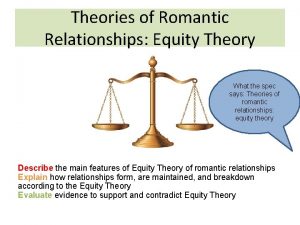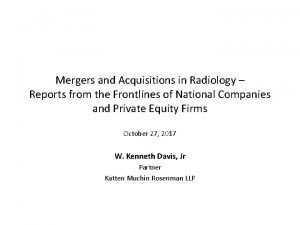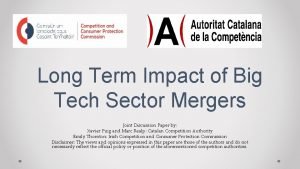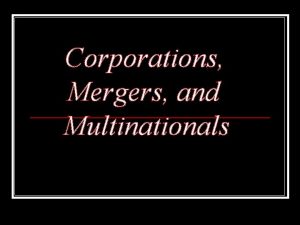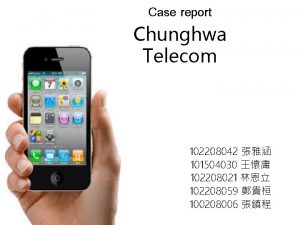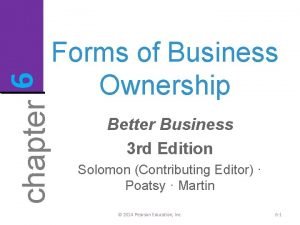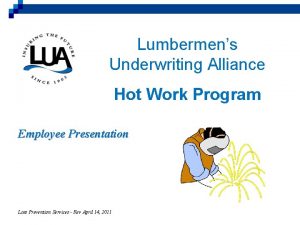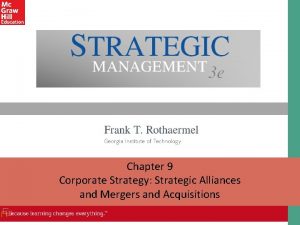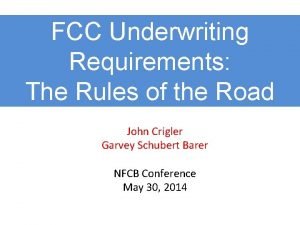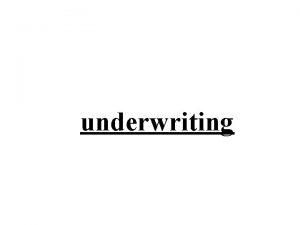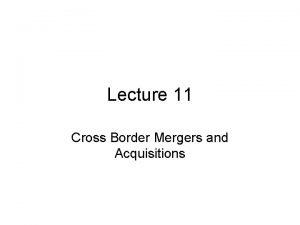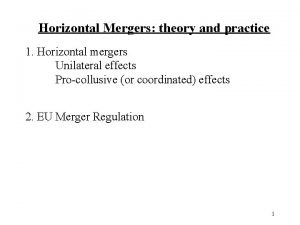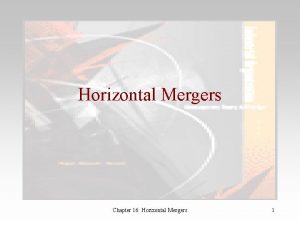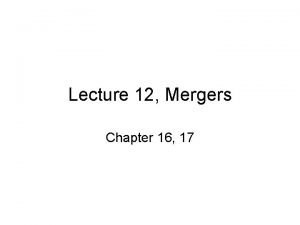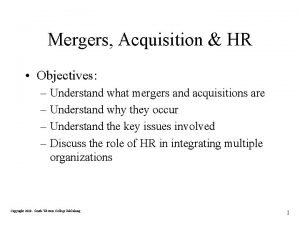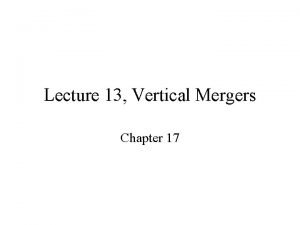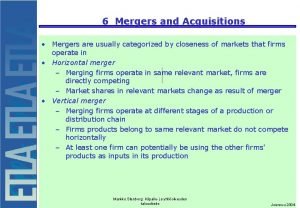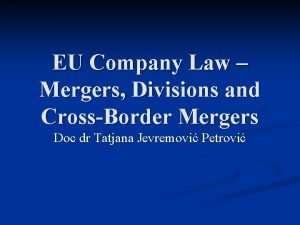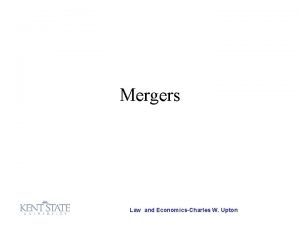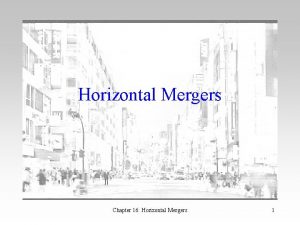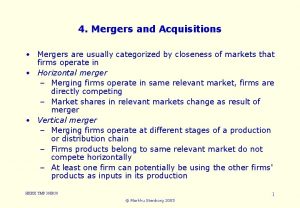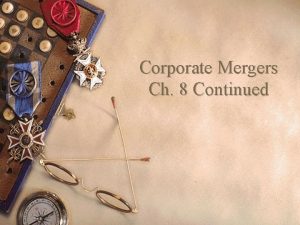The Role of Equity Underwriting Relationships in Mergers
























- Slides: 24

The Role of Equity Underwriting Relationships in Mergers and Acquisitions Hsuan-Chi Chen Anderson School of Management, University of New Mexico Keng-Yu Ho Department of Finance, National Taiwan University Pei-Shih Weng Department of Finance, National Dong Hwa University

Prior Literature • Academic research has provided some evidence of the relationship between lending relationships and future underwriting business. • Drucker and Puri (2005, JF). • SEO underwriters engaged in concurrent lending provide lower underwriting fee and discounted loan yield spread. • Yasuda (2005, JF). • Positive and significant effect of banking relationships on a firm’s underwriter choice for debt issue. • The underwriting fee discount is also significant when the bank is the arranger in the prior loans.

Prior Literature • Ljungqvist, Marston, and Wilhelm (2006, JF). • The main determinant of winning underwriting mandates is the strength of prior underwriting and lending relationships rather than aggressive analyst behavior. • Bharath, Dahiya, Saunders, and Srinivasan (2007, JFE). • Using bank loan, IPO, SEO, and debt issue data. • A bank with (without) prior lending relationship has a chance of 42% (3%) as future loan lender. • Prior lending relationship increase the probability for gaining future debt or equity underwriting business.

Relationship Banking Do prior business relationships affect subsequent transactions? The answer to this general question: “YES”

Motivation • Extend the prior equity underwriting relationships to subsequent M&A advisory (a gap in the literature). • Financial advisors involved in M&As worth more than $1 trillion in 2005, earning advisory fees of $2 billion (Chang, Shekhar, Tam, and Zhu, 2012) • In 2009, global M&A deals announced > 38, 000; the value > $2. 07 trillion.

Research Questions • Does the prior equity underwriting relationship affect the chance of winning subsequent M&A advisory? Yes! • Does the prior underwriting relationship affect the fees of M&A advisory? Yes, the prior underwriting relationship helps reduce the advisory fees for the target firms. • Does the prior underwriting relationship affect the performance (merger synergy) of M&A transaction? Yes, the prior underwriting relationship helps increase the synergy gains for the target firms.

Why equity underwriting relationships? • Extending from James (1992), an equity underwriter may invest in relationship specific assets with its client from due diligence. The established relationship may create a "lock in" effect, making them costly to switch to a different bank for subsequent M&A services. • Extending from Hansen and Torresgrosa (1992), an equity underwriter monitors the underwriting process to ensure good performance and strong leadership. Valuable information is acquired to reduce the monitoring costs of subsequent M&As. • By examining the impacts of failure or near failure of investment banking firms on their industrial clients, Fernando, May, and Megginson (2012) and Kovner (2012) provide evidence supporting the importance of equity underwriting relationships.

Contributions • Filling a gap in the literature, we extend the literature to shed new lights on the role of equity underwriting relationships and provide linkage for the equity underwriting market and M&A advisory market. • Fernando, May, and Megginson (2012) and Kovner (2012) provide evidence supporting the importance of equity underwriting relationships. By exploring the relation between the prior equity underwriting relationships and subsequent M&A advisory, our study contributes to provide a positive answer to the longstanding question of whether firms derive value from investment bank relationships.

Hypothesis 1: The increasing retention likelihood hypothesis • Either theory of relationship-specific assets or theory of underwriter monitoring predicts that the equity underwriting relationship increases the likelihood of advising subsequent mergers and acquisitions for prior underwriting banks. • The bank that underwrites a firm’s IPO/SEOs is more likely to engage in future M&A advisory business with the same firm than other banks that do not have this underwriting relationship.

Hypothesis 2 a: The cost-saving hypothesis • The underwriter-client relationship becomes a valuable asset that lowers the cost and improves the quality of the services provided. The benefits emerge if the bank acquires a better understanding of the client’s operations and learns to work more effectively with the client from due diligence in the underwriting process. The prior underwriting relationship can reduce the advisory fees paid by the acquirers or target firms in subsequent M&As if the firms can capture part of the cost savings from their financial advisors. • Banks that subsequently advise their underwriting clients will charge lower advisory fees than the banks without underwriting relationship.

Hypothesis 2 b: The rent expropriation hypothesis • Banks may not share saving with the clients, particularly if they have informational advantage (Petersen and Rajan (1994)). • Firms may pay higher fees to financial advisors with whom they had relationships in the past if they worry that their advisors may abandon them and advise their merger counterparties (Chang et al. (2012)). • M&A firms will pay higher advisory fees to their M&A financial advisors with underwriting relationship than to those without such relationship.

Hypothesis 3: The positive merger synergy hypothesis • Top-tier investment bankers are able to structure mergers with higher synergies (Golubov et al. (2012)). • We argue that the equity underwriting relationship between the advisors and the firms lowers the information asymmetry and enables investment banks to provide better advisory services. • The equity underwriting relationship between the financial advisors and the firms lowers the information asymmetry and then enables investment banks to provide better advisory services, there would be a positive effect, in term of merger synergy, on the relationship M&A transactions.

Data • Data sources: • IPOs/SEOs/M&As: SDC Platinum of Thomson Reuters • Firm characteristics: CRSP and Compustat • Identifying bank-firm relationship: • Mergers and acquisitions among banks: Assuming the client relationships of an acquired bank are inherited by the acquiring bank.

Data • U. S. M&A deals completed: 1, 580 acquirers and 844 targets from 1995 -2007, excluding firms without SIC codes, financial firms and government agencies, deals without transaction values and firms without hiring financial advisors • 1, 514 U. S. IPOs/SEOs from 1990 -2002 (5 -year lag): Excluding ADRs, REITs, mutual funds, financial firms, utilities, and unit offers • To be included in the final sample, a firm must have at least one equity offering (IPO or SEO) completed within five years before its merger and acquisition announcement. 1, 016 acquirers and 632 targets from 1995 -2007

Descriptive Statistics: Bank-Firm Pairs (Table 1)

Descriptive Statistics (Table 2)

Descriptive Statistics (Table 2 -continued)

Advisor Choice: Probit Model (Table 3)

Advisor Choice: Bivariate Probit Model (Table 4)

M&A Advisory Fee: OLS (Table 5)

M&A Advisory Fee: Heckman Procedure (Table 6)

M&A Synergy Gains: OLS (Table 7)

M&A Synergy Gains: Heckman Procedure (Table 8)

Conclusion • This paper provides evidence on the role of prior equity underwriting relationship in M&As. • We find that a firm tends to choose the bank with prior equity underwriting relationships as the financial advisor in subsequent merger transactions. • We also find that the prior equity underwriting relationship helps reduce the advisory fees and increase the synergy gains for the target firms. • By exploring the relation between the prior equity underwriting relationships and subsequent M&A advisory, our study contributes to partly provide a positive answer to the long-standing question of whether firms derive value from investment bank relationships.
 Equity theory relationships
Equity theory relationships Hr issues in mergers and acquisitions
Hr issues in mergers and acquisitions Gregor andrade
Gregor andrade What is underwriting in corporate accounting
What is underwriting in corporate accounting Dc open doors program
Dc open doors program Radiology mergers and acquisitions
Radiology mergers and acquisitions Marc realp
Marc realp Merge vs acquire
Merge vs acquire Corporations mergers and multinationals
Corporations mergers and multinationals Debt underwriting
Debt underwriting Telecom mergers
Telecom mergers Merger and acquisition
Merger and acquisition Mergers in strategic management
Mergers in strategic management Vertical merger
Vertical merger What is debenture
What is debenture What is corporate restructuring
What is corporate restructuring Franchise mergers & acquisitions advisors
Franchise mergers & acquisitions advisors Better business forms
Better business forms Cyber liability insurance presentation
Cyber liability insurance presentation Royal london medical underwriting limits
Royal london medical underwriting limits Mergers and acquisitions rumors
Mergers and acquisitions rumors Lumbermens underwriting alliance
Lumbermens underwriting alliance In terms of the build borrow or buy framework
In terms of the build borrow or buy framework Underwriting workflow
Underwriting workflow Fcc underwriting rules
Fcc underwriting rules
